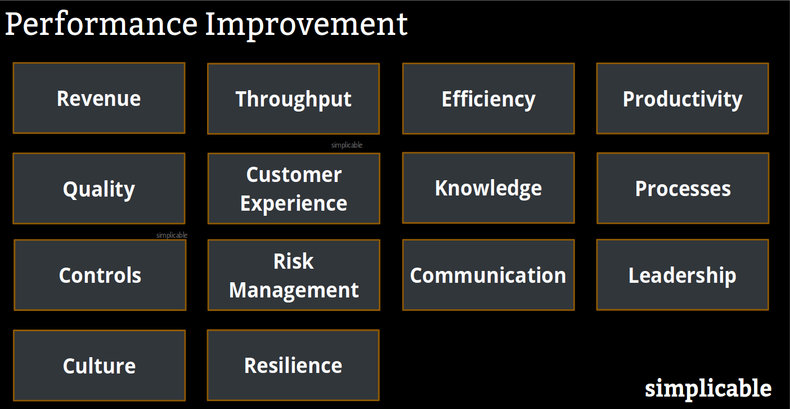

Revenue
Directly achieving more revenue such as a sales team that needs to start closing more sales.Throughput
Doing more work. For example, a software developer who completes 1000 lines of code a month who improves their throughput to 1000 lines a week.Efficiency
Doing more with less such as a maintenance team that is able to cut business travel costs by using a digital twin to inspect infrastructure remotely.Productivity
Doing more in an hour of work. For example, an employee who finds a way to get through their daily emails in 20 minutes as opposed to 3 hours.Quality
Improving the value of your output such as an employee who improves the content and professional style of their business emails.Customer Experience
Improving things for the customer such as making a product more usable or a service more friendly.Knowledge
Acquiring and refining valuable knowledge. For example, a solar panel manufacturer that develops advance knowledge of battery systems in preparation for launching a new product line.Processes
Valuable change to processes such as an ecommerce company that is able to return and reuse the boxes they send to customers in order to reduce their environmental impact and costs.Controls
Introducing or improving internal controls. For example, implementing segregation of duties such that different people approve sales deals and manage sales teams to prevent conflict of interest.Risk Management
Risk management improvements such as maintenance workers who physically point at things as they inspect them to reduce the risk of human error.Communication
Improving communications such as a manager who improves team meetings to be more useful to the team.Leadership
Leadership improvements such as a skilled software developer who begins to mentor team members and provide technical direction to products.Culture
Improvements to team culture such as a sales team that adopts the habit of sharing lessons learned for opportunities that failed to close.Resilience
Increasing the resilience of an organization, team or individual to stress. For example, a team that is completely cross-trained such that every member can perform every other member's role including management. Such a team can continue to operate when someone gets sick or quits.| Overview: Performance Improvement | ||
Type | ||
Definition | The evaluation of performance followed by efforts to improve that performance. | |
Related Concepts | ||


































